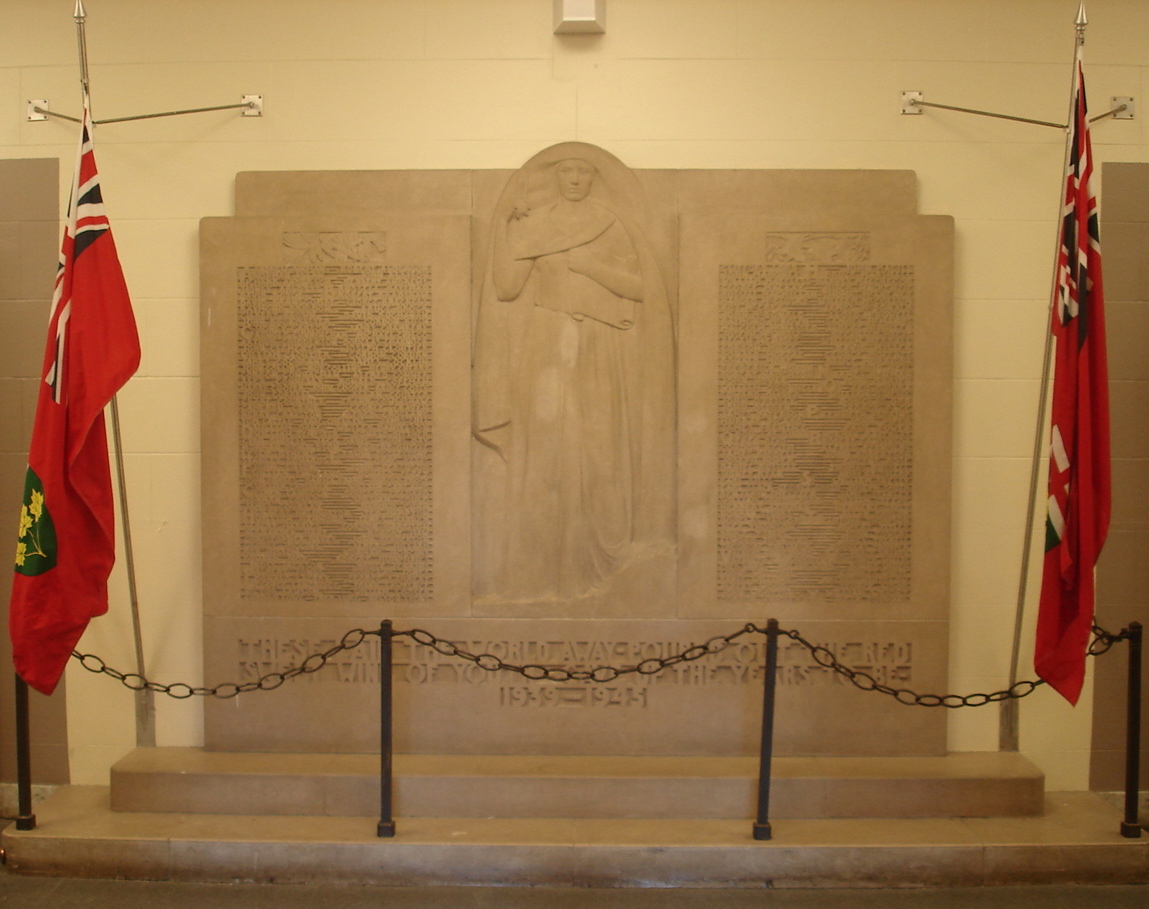
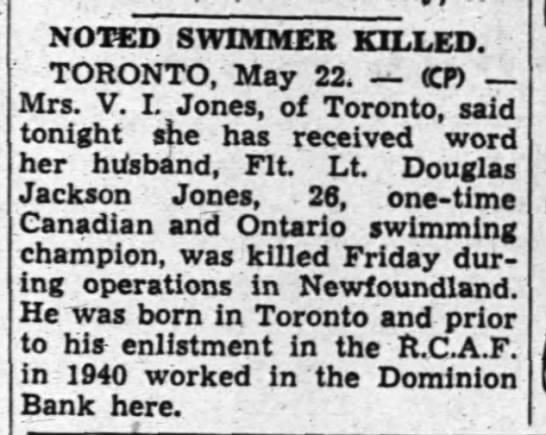
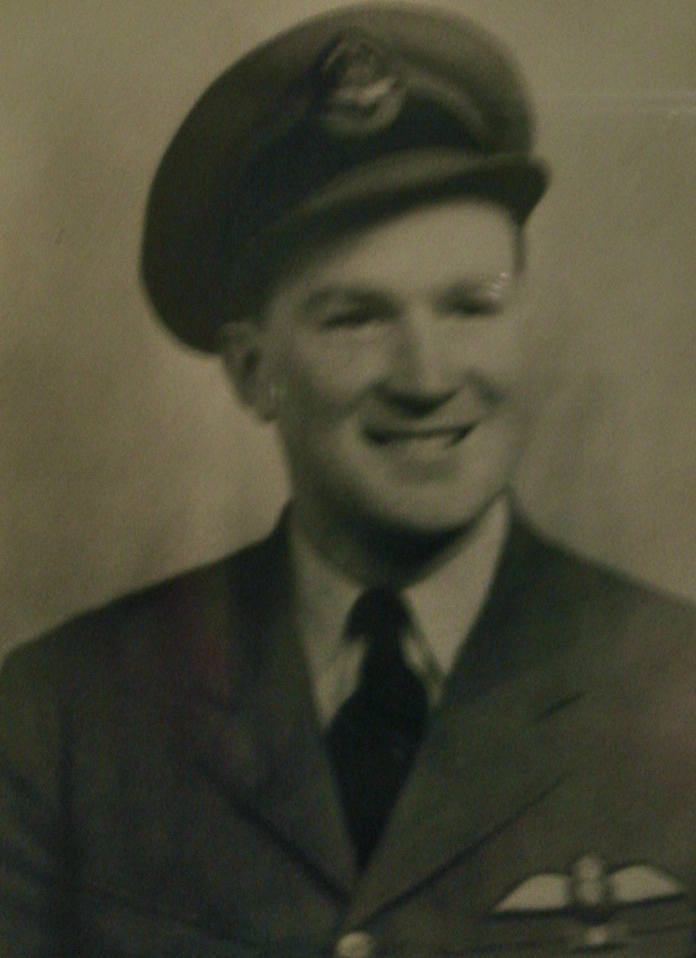
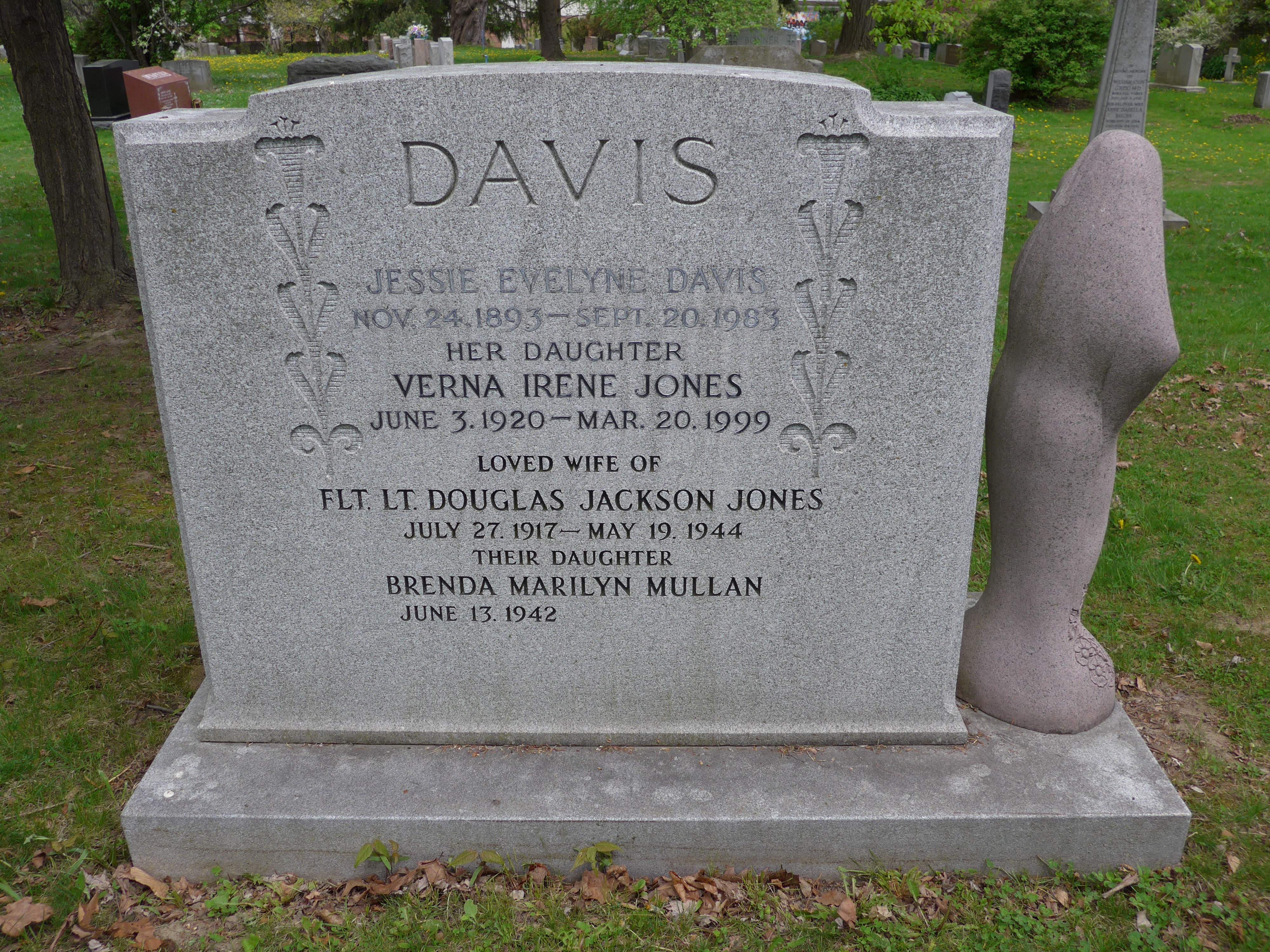

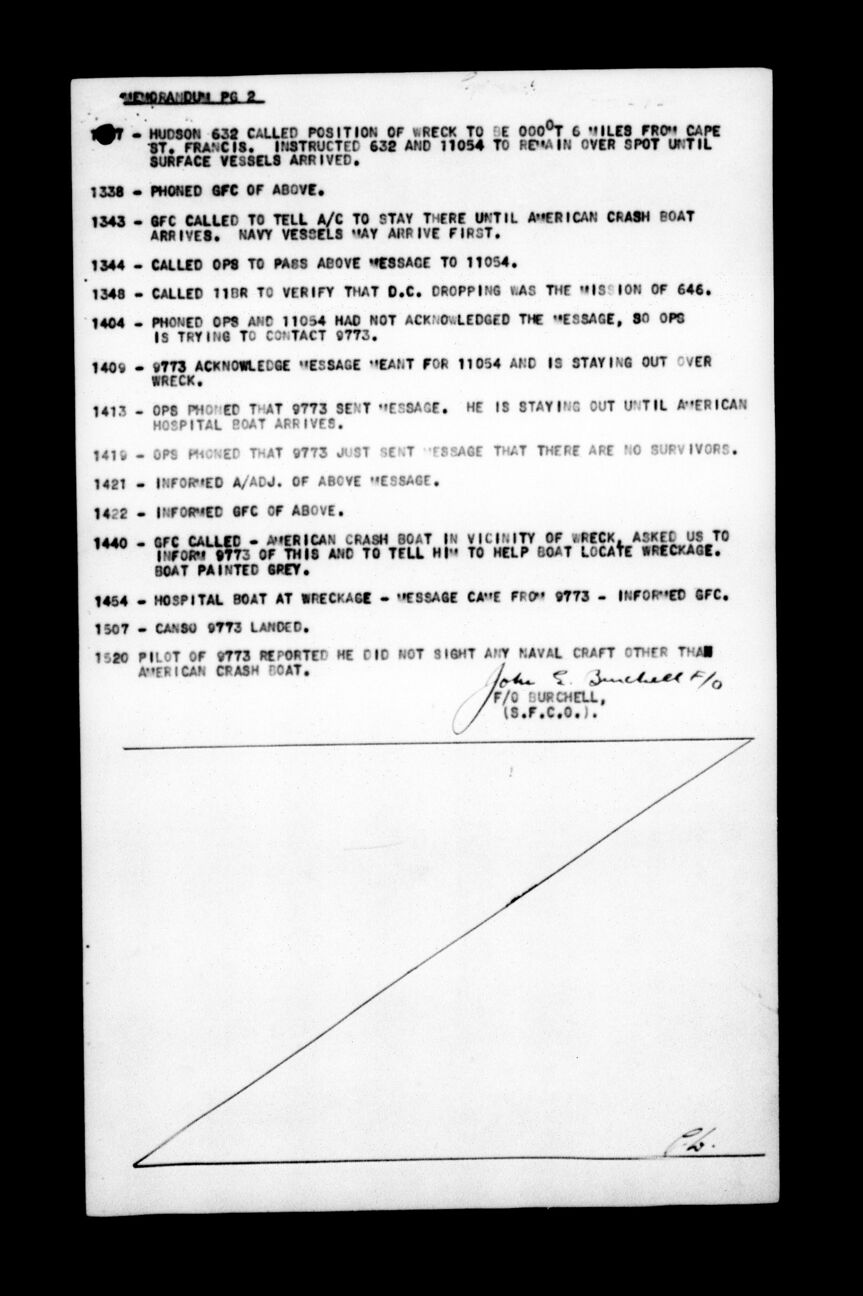
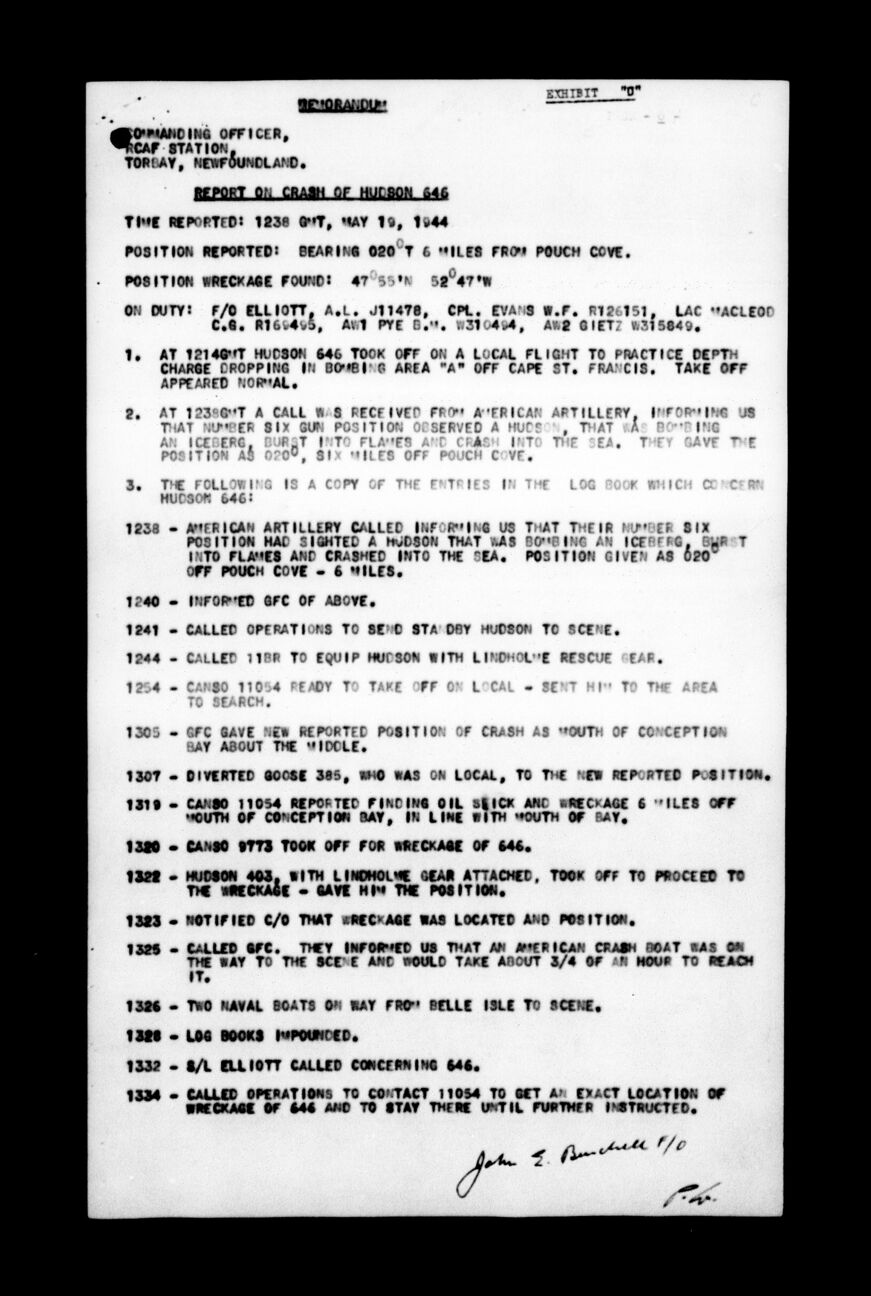
July 27, 1917 - May 19, 1944







Douglas Jackson Jones as the son of Frank Jones, haberdasher, and Violet Lillian (nee Jackson) Jones of Toronto. He had brothers: William Henry Jones, Robert Hollister Jones, and Donald Frank Jones. The family was Presbyterian.
He was a highly skilled swimmer, winning many trophies, a one-time Canadian and Ontario swimming champion, including one in a New York State competition. He also liked to ski, box, and sail. He fractured his left wrist when he was 12. He did not drink, nor smoke. Douglas worked at the Dominion Bank of Canada from 1937 to 1940 where he was ledgerkeeper. He listed photography and painting as hobbies.
Douglas started his journey through the BCATP at No. 2 Manning Depot, Brandon, Manitoba on August 15, 1940.
“Very keen on flying. Hasn’t done any yet. Made a good showing in Cadet Corps. Excellent at sports, especially swimming. Should make good bomber pilot.” He stood 6’ tall and weighed 171 pounds. Douglas had blue eyes and brown hair. “An excellent type of chap. He is an extremely good athlete. He is keen on flying and appears to have a very good mind.”
At No. 2 ITS, Regina, November 16 - December 16, 1940: “1st in class of 84. 88%. Good background. Keen and sensible.”
At No. 8 EFTS, Sea Island, BC, from December 23, 1940 to February 9 1941: “Above average.” Ground training: “1st out of 29 in class. Conduct excellent. Willing and very capable. Above average in his flying and exceptional in his ground work. Should go far.”
No. 3 SFTS, Calgary, Alberta, February to May 1941: “An above average pilot. No outstanding faults.” Ground School: “90%. First in class. Very satisfactory effort.” Other comments: “Grasps very easily. Progressed rapidly and very satisfactory. Pleasant. Frank personality. Well mannered. Self-assured. Keen and alert. Studious. Should make good officer.” He was awarded his Pilot’s Flying Badge on May 28, 1941 with Special Distinction.
Douglas married Verna Irene Davis (1920-1999) on June 6, 1941. She resided in Toronto. They had a daughter, Brenda Marilyn who was born on June 13, 1942. Douglas had a joint account with Verna at the Toronto General Trusts Corp. with $174.56, plus $225 in War Savings Certificates. He also had a life insurance policy, with Verna as the beneficiary.
June 29, 1942: “Extremely overconfident. High average ability as a pilot; instrument flying average. Aerobatics not tested. Flying discipline poor. Manner in air too cock-sure. Must improve his attitude and overcome his overconfidence.” S/L William Foster, No. 2 Visiting Flight.
Douglas was at Trenton for a Flying Instructors’ Course July 7 to August 21, 1942. “Good average pilot. Should do well with experience.” More comments: “Will make an above average instructor with experience.” F/L R. J. Bennell, CFS, Trenton. October 1, 1941.
Evaluations: November 6, 1941: “Steady type who will probably make an excellent instructor when he settles down.” December 5, 1941: “A quiet, steady type of officer who has carried out all his duties satisfactorily.” August 15, 1942: “This officer had an adverse report from CES visiting flight, chiefly on account of his attitude to his work. He is now showing some improvement.” November 27, 1942: “A keen intelligent officer who works hard. Possesses a marvellous attitude and cheerfully accepts any work assigned to him.” December 29, 1942: 13 months instructor RAF School. Outstanding swimmer and athlete. Hard worker. Keen and intelligent.” March 26, 1943: “All flying shows lack of recent practice. Sequence could be improved by inclusion of minor detail.” May 21, 1943: “Enthusiastic and co-operative. A welcome sense of humour. Tries hard and gets things done.” September 13, 1943: “Very energetic and co-operative. Inclined to complain regularly but a very good worker. Did a good job at this unit.” December 27, 1943: “Considerable experience on an elementary FTS. This officer is considered a very capable and efficient flight commander. Willing to work hard and cooperative in every respect. Gets good results.”
While at GRS, Summerside, PEI, September 29 - November 10, 1943: “86.9%. 1st out of 22 in class. By far the most outstanding man in the class. An excellent navigator and very pleasant personality. He should make an excellent GR pilot. An ex- SFTS instructor with considerable flying who worked hard and achieved a very high standard in this course, especially in Navigation.”
Douglas was posted to No. 11 Squadron December 8, 1943. He was at the station hospital December 17-19, 1943.
On the Pilot Armament Officer course in Mountain View, Ontario, the spring of 1944: “87.6%. 1st in class of 12. Above average. A worker. Thinks and acts for himself. He showed interest throughout the course. A good type of officer.”
SUMMARY: Aboard Hudson BW646, 11 BR Squadron, Torbay, Newfoundland, were WIRELESS AIRGUNNER WO1 John Henry Cowan, R95716, PILOT F/L Douglas Jackson Jones, J5664, and NAVIGATOR WO1 Laurence George Martin, R134391. The aircraft was taken on strength February 5, 1942, by Eastern Air Command for Home War Establishment, one of 55 Hudson’s released off a British Lend Lease contract. Hudson BW646 failed to return from patrol on May 19, 1944, after a depth charge dropping practice. Position: 47 degrees 55 minutes north, 52 degrees 47 minutes west.
COURT OF INQUIRY: May 20 - 23, 1944. FIRST WITNESS: Private Theodore George DeMores (1919-2004), US Army serving at Fort Pepperrell, Newfoundland: “On the morning of May 19, 1944, I was on duty as observer near Pouch Cove and at approximately 0930 hours, I observed a Hudson bomber flying in a northerly direction to a point above Baccalieu Island [largest seabird island in Newfoundland, highest elevation 137 m, 449 feet, area 5 square km/1.9 sq. miles] which he circled at approximately a thousand feet. From Baccalieu Island, he proceeded down the northwestern side of Conception Bay to Western Bay. The aircraft circled counter-clockwise and commenced to descend flying low over a flat cake of ice. He turned counter-clockwise and repeated the procedure. As the plane passed over the iceberg the second time, a black puff of smoke appeared under the fuselage. It was only a matter of seconds until the front end of the plane burst into flames. Then the aircraft veered to the left, hit the water, exploded and sank immediately. A large column of black smoke rose from the spot.” SECOND WITNESS: Captain William Broderick, Master of fishing Schooner, Lady Bungay, of Grates Cove, Newfoundland, civilian stated: “I was sailing my schooner, Landy Bungay, down from Grates Cover to St. John’s on 19-May-1944 and at approximately 0955 hours, I saw an aeroplane circle low over an iceberg at about 150-200 feet. I saw one column of water rise from a point close to the iceberg. A short time after this, a red glow appeared at the front of the aircraft and the aircraft continued its descent into the water and blew up on impact with the water and a large column of black smoke arose from the spot. We felt the explosion when the aircraft hit the water and there was a large column of water arose with black smoke following.” FOURTH WITNESS: Cpl. William Mullen Mitchell, R117980, Armourer Bombs, No. 11 Squadron, RCAF Torbay, Newfoundland. He stated that “at approximately 1100 hours May 18, 1944, I supervised the bombing up of Hudson 646 with four Mark VIIII amatol filled depth charges and eight 11 ½ pound practice bombs. Prior to bombing up, normal checks on the bomb circuit were carried out and the circuits were all satisfactory. The aircraft did not take off that day as scheduled but took off the following day at approximately 0945 hours. The installation of the pistols on the depth charges are done by the HQ’s Armament Section. It is my opinion that a depth charge cannot explode while it is still on the carrier. There were no unauthorized explosives on board in Hudson 646.”
Operations was called to send a stand-by Hudson to the scene with Lindholme rescue gear. Canso 11054 was sent to the are to search for survivors. Canso 11054 reported finding an oil slick and wreckage six miles off mouth of Conception Bay in line with the mouth of the bay. Two other airplanes were involved in the search. An American crash boat was on its way to the scene, along with two naval boats form Belle Isle. A hospital boat was also sent. Hudson 632 called the position of the wreck six miles from Cape St. Francis. Canso 11054 and Hudson 632 were told to remain over the spot until the surface vessels arrived. Canso 9773 was also contacted, and they stayed out over the site of the wreck. [Canso 9773 was lost disposing of old dynamite May 20, 1944.]. Canso 9773 reported that there were no survivors, its pilot reporting he did not see any naval craft other than the American crash boat at the scene. [The first pilot aboard Canso 9773 was F/O Leo James Murray; the second pilot was F/L Alan Gordon Byers. Both their names are on the Ottawa Memorial, along with their crew. They were disposing of old dynamite over icebergs.] The wreckage picked up included a tire and wheel, one smoke bomb, one broken ammunition box (calibre 50) and one broken piece of floorboard. The President of the Court flew to the scene of the accident in Hudson BW403 with Lindholme gear and all that was seen was an oil slick and small bits of floating wreckage. The aircraft had sunk.
FINDINGS OF THE INVESTIGATION: CAUSE: One depth charge exploded on impact with water or ice causing aircraft gasoline tanks to fracture. Exhaust flame ignited gasoline. Fire enveloped most of the front portion of the aircraft causing pilot to lose control. Aircraft disintegrated on impact with water. Remaining depth charges exploded. Recommendations: as a safety measure, icebergs are not to be used as targets for depth charge practice attacks. Conclusions of Accident Investigation Branch: The cause is actually obscure. There is not sufficient evidence to support the court’s finding but nevertheless it is probably what happened.
MEMO: June 28, 1944: FIRE IN AIR IN HUDSON AIRCRAFT -- G/C F. S. Wilkins, CI Accidents 1. In view of the fact that we have had three accidents due to fire in air in Hudson aircraft and in each case the aircraft dived into the sea and no examination could be made, I detailed one of the staff to examine any Hudson’s within easy reach of Ottawa in an attempt to find where such fires could originate. Such an examination would, of course, not be conclusive but might give us something to work on. Flight Lieutenant pula examined a number of such aircraft at Rockcliffe. You will see by his attached report that the washers being used in gasoline filters are, in most cases, non-standard. One aircraft he examined showed definite signs of a gasoline leak from the filter having impinged on the inside of the Cowling. In addition to these failures, I attach two pieces of flexible hose from the same area of the engine installation which are unsatisfactory. The long piece is bent into a ‘U’ an dshows signs of failure from the fabric; The short piece has definite indications of cutting in by the clips. Any of these defects could come in the right set of circumstances, caused fire in the air. Two period when the defects concerning the washers were found, the unit could not obtain any standard washers and sent to Montreal for supplies. I spoke to D. R. M. About this shortage of washers. I have now been informed that all carburetor spares are concentrated in No. 1 E. D. Toronto. Toronto, as far as I know, has never had any number of Hudson aircraft station in the vicinity and I am very much of the opinion that the units equipped with Hudson’s are making up their own washers because they do not know where to obtain the proper ones.
In late October 1955, Verna received a letter informing her that since her husband had no known grave, his name would appear on the Ottawa Memorial. Verna never remarried. Douglas’s name is on the Davis headstone in the Mount Pleasant Cemetery, Toronto. Douglas’s name also appears on the Western Technical School’s memorial to those who served and did not return. (He attended that school from 1932-1936.)
LINKS: